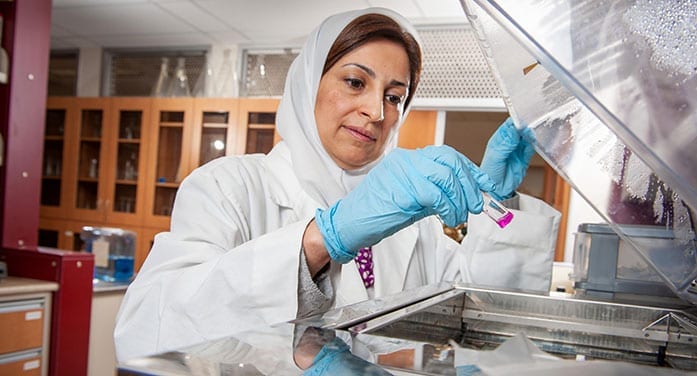A University of Alberta researcher is using nanotechnology to improve the effectiveness of chemotherapy treatments for cancer patients and reduce their side effects.
Afsaneh Lavasanifar is a professor in the University of Alberta’s Faculty of Pharmacy & Pharmaceutical Sciences and an adjunct professor in the Department of Chemical and Medical Engineering. Her lab develops precision health solutions through nanomedicine, finding ways to deliver drug-loaded nanoparticles to tumour sites.
“In nanomedicine, we are either working to improve the effectiveness of drugs that are already on the market or making new and better drugs by using (delivery) ‘vehicles’ that are in the nanometre-size range,” explained Lavasanifar. “These vehicles either make the drugs more effective or reduce their side-effects or both.”

Afsaneh Lavasanifar is using nanotechnology to develop precise ways of delivering anti-cancer drugs to tumours, which could improve outcomes for patients while reducing side-effects of treatment. (Photo: Richard Siemens)
Lavasanifar, also a member of the Cancer Research Institute of Northern Alberta (CRINA), trained as a pharmacist in her home country of Iran before earning her PhD at the U of A. She was drawn to this research area after seeing how many cancer patients suffered due to chemotherapy side-effects.
Current chemotherapy drug treatments are targeted to destroy the body’s cancer cells, which multiply quickly, but other rapidly growing normal cells also end up as drug targets. The toxic effects of chemotherapy can even be seen in normal cells that are not fast-growing.
The other issue with current chemotherapy delivery is that it is given systemically, usually through intravenous injection. The drug or drug combination then ends up everywhere in the body, which lowers its effectiveness.
Lavasanifar’s research group has developed nanoparticles that act as a host to the anti-cancer drugs, dictating their distribution in the body to redirect the drugs from normal tissues to tumour targets. Increasing the tumours’ exposure to the drugs makes the treatment more effective, and reducing the exposure of normal cells to chemotherapy reduces side effects.
The delivery system is based on polymers Lavasanifar has developed that come together and form the nanoparticles. The technology makes the drugs water-soluble, allowing them to be given intravenously. With higher solubility, the drugs may be absorbed better orally as well.
The technology has been licensed to Meros Polymers, a spinoff company started by Lavasanifar and other investors. While the main focus is to use these drug-delivering nanoparticles in cancer therapy, Meros recently licensed the technology to another company to treat heart failure.
So far, Lavasanifar’s team has been working on the nanomedicine project in the lab, using mice and rats. Her lab has tested the delivery system on many types of cancer, including breast, colorectal, lung, head and neck and multiple myeloma. The technology performed well in all of them, although there may have to be modifications to the nanoparticles for some cancer types.
Lavasanifar’s team is also working to make radiotherapy more effective. In an ongoing collaboration with oncologist Frank Wuest, they’re making nanoparticles trackable (using positron emission tomography or PET scans) in supplementary drugs delivered to tumour sites. Once the PET scan determines that a high quantity of the drug has accumulated in the tumour, the radiologist can apply radiation to the same site, enhancing its effectiveness.
“Broadly speaking, precision medicine means giving the right drug to the right patient at the right place and at the right time,” said Lavasanifar. In chemotherapy, her nanomedicine project aims to ensure that anti-cancer drugs are delivered to the right target. In radiotherapy, they are tracking nanoparticles to ensure that radiation exposure happens at the right time.
Her research has had significant funding support from agencies including the Alberta Cancer Foundation, the Natural Sciences and Engineering Research Council of Canada, the Canadian Institutes of Health Research, Alberta Innovates and the Nanomedicines Innovation Network. But it takes a huge amount of resources to move to the clinical trial stage, she says.
She’s grateful for the world-class facilities and labs at the U of A, as well as the support of the life sciences commercialization organization Applied Pharmaceutical Innovation. “We have received cutting-edge instruments, the best of the best that’s available. The University of Alberta has always been very supportive of research, and that is why it is known around the globe for the quality of its research.”
If her nanomedicine research can help cancer patients in the future, it will further enhance the university’s reputation in collaborating with industry to bring important medical advances to the market, she said. “And that will create jobs here in Alberta, which is very much needed.”
| By Keri Sweetman for Troy Media
This article was submitted by the University of Alberta’s Folio online magazine. The University of Alberta is a Troy Media Editorial Content Provider Partner.
© Troy Media
Troy Media is an editorial content provider to media outlets and its own hosted community news outlets across Canada.



